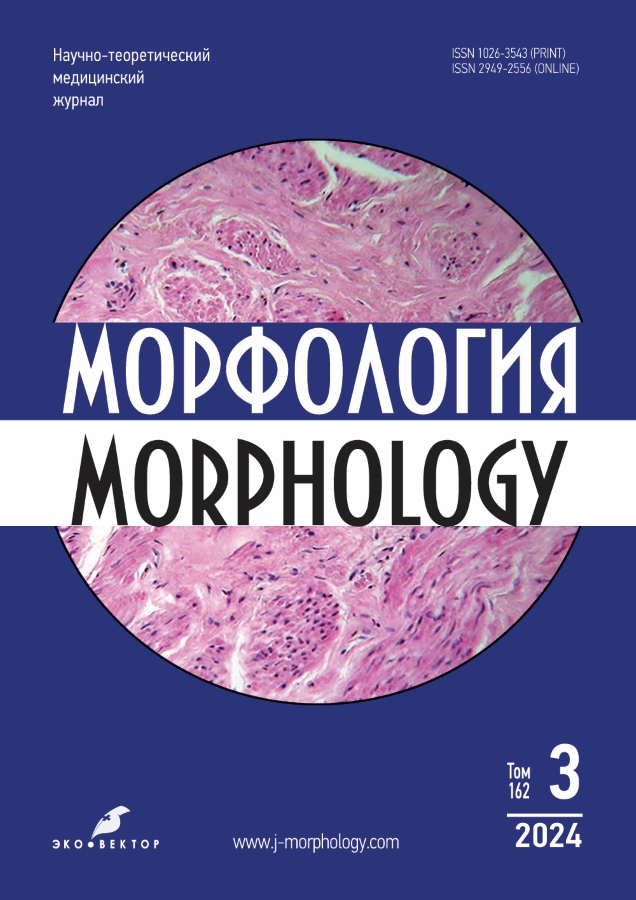人脑半球皮层中与淀粉样蛋白斑相关的突触结构的形态特征
- 作者: Guselnikova V.V.1, Razenkova V.A.1, Fedorova E.A.1, Korzhevsky D.E.1
-
隶属关系:
- Institute of Experimental Medicine
- 期: 卷 162, 编号 3 (2024)
- 页面: 330-339
- 栏目: Original Study Articles
- ##submission.dateSubmitted##: 06.08.2024
- ##submission.dateAccepted##: 30.09.2024
- ##submission.datePublished##: 15.12.2024
- URL: https://j-morphology.com/1026-3543/article/view/634895
- DOI: https://doi.org/10.17816/morph.634895
- ID: 634895
如何引用文章
详细
论证。进行性和不可逆的突触丧失是阿尔茨海默病(AD)的关键表现之一,且与患病的认知障碍程度相关。突触的病理学研究对于理解AD的发病机制和进展机制可能具有决定性意义。因此,分析这种病理发展过程中突触的结构和功能变化是一项重要任务。在此类研究中,最可靠和最广泛使用的突触标记之一是突触素,它是一种突触小泡膜中的蛋白质。
目的 — 研究淀粉样蛋白斑形成过程中人脑皮层中含有突触素的结构的形态特征。
材料和方法。该研究的材料是65至94岁男性和女性的大脑皮层样本(n=10)。为了同时查明突触和淀粉样斑块,使用了一种新的光学显微镜独创技术,该技术基于突触素蛋白的免疫组织化学检测和用组织化学染料阿尔新蓝对淀粉样斑块进行染色。
结果。大多数淀粉样蛋白斑显示出异常的突触素免疫阳性结构,推测这些结构是营养不良性的突触前。这些结构的特点是尺寸大、形状不清晰,并且仅存在于淀粉样蛋白斑的组成中。一个有趣的发现是,在所有研究的大脑皮层样本中都发现了所谓的多糖体(淀粉体),这些多糖体具有明显的球形特征,主要位于脑膜附近、脑室周围和血管周围。多糖体周围的突触素免疫阳性末端始终具有典型的结构和分布密度,不表现出病理迹象。
结论。在老年痴呆症患者、高龄人和长寿人的大脑半球皮层中,会形成异常的含突触素的结构,这些结构位于淀粉样蛋白斑块内或周围。包括在AD情况下,从确定突触紊乱的新生物标志,以及寻找这种疾病的早期诊断标志物的角度来看,进一步研究这些结构是很有前景的。
全文:
作者简介
Valeria V. Guselnikova
Institute of Experimental Medicine
编辑信件的主要联系方式.
Email: Guselnicova.Valeriia@yandex.ru
ORCID iD: 0000-0002-9499-8275
SPIN 代码: 5115-4320
Cand. Sci. (Biology)
俄罗斯联邦, Saint PetersburgValeria A. Razenkova
Institute of Experimental Medicine
Email: valeriya.raz@yandex.ru
ORCID iD: 0000-0002-3997-2232
SPIN 代码: 8877-8902
俄罗斯联邦, Saint Petersburg
Elena A. Fedorova
Institute of Experimental Medicine
Email: el-fedorova2014@ya.ru
ORCID iD: 0000-0002-0190-885X
SPIN 代码: 5414-4122
Cand. Sci. (Biology)
俄罗斯联邦, Saint PetersburgDmitry E. Korzhevsky
Institute of Experimental Medicine
Email: dek2@yandex.ru
ORCID iD: 0000-0002-2456-8165
SPIN 代码: 3252-3029
MD, Dr. Sci. (Medicine), Professor of the Russian Academy of Sciences
俄罗斯联邦, Saint Petersburg参考
- Meftah S, Gan J. Alzheimer’s disease as a synaptopathy: Evidence for dysfunction of synapses during disease progression. Front Synaptic Neurosci. 2023;15:1129036. doi: 10.3389/fnsyn.2023.1129036
- Scheltens P, De Strooper B, Kivipelto M, et al. Alzheimer’s disease. Lancet. 2021;397(10284):1577–1590. doi: 10.1016/S0140-6736(20)32205-4
- Condello C, Schain A, Grutzendler J. Multicolor time-stamp reveals the dynamics and toxicity of amyloid deposition. Sci Rep. 2011;1:19. doi: 10.1038/srep00019
- Colom-Cadena M, Spires-Jones T, Zetterberg H, et al. The clinical promise of biomarkers of synapse damage or loss in Alzheimer’s disease. Alzheimers Res Ther. 2020;12(1):21. doi: 10.1186/s13195-020-00588-4
- Peng L, Bestard-Lorigados I, Song W. The synapse as a treatment avenue for Alzheimer’s disease. Mol Psychiatry. 2022;27(7):2940–2949. doi: 10.1038/s41380-022-01565-z
- Lacor PN, Buniel MC, Furlow PW, et al. Abeta oligomer-induced aberrations in synapse composition, shape, and density provide a molecular basis for loss of connectivity in Alzheimer’s disease. J Neurosci. 2007;27:796–807. doi: 10.1523/JNEUROSCI.3501-06.2007
- Subramanian J, Savage JC, Tremblay MÈ. Synaptic loss in Alzheimer’s disease: mechanistic insights provided by two-photon in vivo imaging of transgenic mouse models. Front Cell Neurosci. 2020;14:592607. doi: 10.3389/fncel.2020.592607
- Hesse R, Hurtado ML, Jackson RJ, et al. Comparative profiling of the synaptic proteome from Alzheimer’s disease patients with focus on the APOE genotype. Acta Neuropathologica Commun. 2019;7:214. doi: 10.1186/s40478-019-0847-7
- Rajendran L, Paolicelli RC. Microglia-mediated synapse loss in Alzheimer’s disease. J Neurosci. 2018;38(12):2911–2919. doi: 10.1523/JNEUROSCI.1136-17.2017
- Martínez-Serra R, Alonso-Nanclares L, Cho K, Giese KP. Emerging insights into synapse dysregulation in Alzheimer’s disease. Brain Commun. 2022;4(2):fcac083. doi: 10.1093/braincomms/fcac083
- Griffiths J, Grant SGN. Synapse pathology in Alzheimer’s disease. Semin Cell Dev Biol. 2023;139:13–23. doi: 10.1016/j.semcdb.2022.05.028
- Yasuhara O, Kawamata T, Aimi Y, et al. Two types of dystrophic neurites in senile plaques of Alzheimer disease and elderly non-demented cases. Neurosci Lett. 1994;171(1-2):73–76. doi: 10.1016/0304-3940(94)90608-4
- DeTure MA, Dickson DW. The neuropathological diagnosis of Alzheimer’s disease. Mol Neurodegener. 2019;14(1):32. doi: 10.1186/s13024-019-0333-5
- Sanchez-Varo R, Trujillo-Estrada L, Sanchez-Mejias E, et al. Abnormal accumulation of autophagic vesicles correlates with axonal and synaptic pathology in young Alzheimer’s mice hippocampus. Acta Neuropathol. 2012;123(1):53–70. doi: 10.1007/s00401-011-0896-x
- Sadleir KR, Kandalepas PC, Buggia-Prévot V, et al. Presynaptic dystrophic neurites surrounding amyloid plaques are sites of microtubule disruption, BACE1 elevation, and increased Aβ generation in Alzheimer’s disease. Acta Neuropathol. 2016;132(2):235–256. doi: 10.1007/s00401-016-1558-9
- Kolos YeA, Grigoriyev IP, Korzhevskyi DE. A synaptic marker synaptophysin. Morphology. 2015;147(1):78–82. EDN: TIJLST doi: 10.17816/morph.398838
- Gudi V, Gai L, Herder V, et al. Synaptophysin is a reliable marker for axonal damage. J Neuropathol Exp Neurol. 2017;76(2):109–125. doi: 10.1093/jnen/nlw114
- Carson RE, Naganawa M, Toyonaga T, et al. Imaging of synaptic density in neurodegenerative disorders. J Nucl Med. 2022;63(Suppl. 1):60S–67S. doi: 10.2967/jnumed.121.263201
- Snow PM, Patel NH, Harrelson AL, Goodman CS. Neural-specific carbohydrate moiety shared by many surface glycoproteins in Drosophila and grasshopper embryos. J Neurosci. 1987;7(12):4137–4144. doi: 10.1523/JNEUROSCI.07-12-04137.1987
- Nosova OI, Guselnikova VV, Korzhevskii DE. Light microscopy approach for simultaneous identification of glial cells and amyloid plaques. Cell and Tissue Biology. 2022;16(2):140–149. EDN: EUVGGX doi: 10.1134/S1990519X22020080
- Guselnikova VV. Comparative analysis of histological methods used for identification of amyloid plaques in the human brain. Genes and cells. 2020;15(S3):158–159. EDN: MREAMV doi: 10.23868/gc123163
- Guselnikova VV, Antipova MV, Fedorova EA, et al. Distinctive features of histochemical and immunohistochemical techniques for amyloid plaque. Journal of Anatomy and Histopathology. 2019;8(2):91–99. EDN: YJHMVM doi: 10.18499/2225-7357-2019-8-2-91-99
- Pirici D, Margaritescu C. Corpora amylacea in aging brain and age-related brain disorders. J Aging Gerontol. 2014;2(1):33–57. doi: 10.12974/2309-6128.2014.02.01.6
- Navarro PP, Genoud C, Castaño-Díez D, et al. Cerebral Corpora amylacea are dense membranous labyrinths containing structurally preserved cell organelles. Sci Rep. 2018;8(1):18046. doi: 10.1038/s41598-018-36223-4
- Augé E, Bechmann I, Llor N, et al. Corpora amylacea in human hippocampal brain tissue are intracellular bodies that exhibit a homogeneous distribution of neo-epitopes. Sci Rep. 2019;9(1):2063. doi: 10.1038/s41598-018-38010-7
- Singhrao SK, Neal JW, Newman GR. Corpora amylacea could be an indicator of neurodegeneration. Neuropathol Appl Neurobiol. 1993;19(3):269–276. doi: 10.1111/j.1365-2990.1993.tb00437.x
- Takahashi K, Iwata K, Nakamura H. Intra-axonal corpora amylacea in the CNS. Acta Neuropathol. 1977;37(2):165–167. doi: 10.1007/BF00692062
- DeKosky ST, Scheff SW. Synapse loss in frontal cortex biopsies in Alzheimer’s disease: correlation with cognitive severity. Ann Neurol. 1990;27(5):457–464. doi: 10.1002/ana.410270502
补充文件







